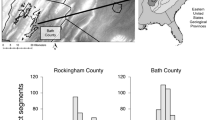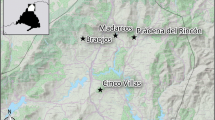Abstract
The swift fox Vulpes velox Say, 1823, a small canid native to shortgrass prairie ecosystems of North America, has been the subject of enhanced conservation and research interest because of restricted distribution and low densities. Previous studies have described distributions of the species in the southern Great Plains, but data on density are required to evaluate indices of relative abundance and monitor population trends. We examined regressions of swift fox density (estimated by mark-recapture) on timed-track surveys, scat surveys, and catch-per-unit effort indices. Seventy-nine swift foxes (42 male, 37 female) were captured 151 times during 10 240 trapnights between May 2003 and December 2004 in the Panhandle of Oklahoma, USA. Density estimates, based on mark-recapture data from autumn 2004, were 0.08–0.44 foxes/km2. Survey indices explained 51 to 76% of the variation in estimates of fox density. Our study indicates that surveys of time-to-track encounters and scat deposition rates show promise in monitoring trends in population abundance over large areas.
Similar content being viewed by others
References
Allardyce D. and Sovada M. A. 2003. A review of the ecology, distribution, and status of swift foxes in the United States. [In: The swift fox: ecology and conservation of swift fox in a changing world. M. A. Sovada and L. N. Carbyn, eds]. Canadian Plains Research Center, University of Regina, SK: 3–18.
Burnham K. P., and Anderson D. R. 1998. Model selection and inference: a practical information-theoretic approach. Springer-Verlag, New York: 1–353.
Cypher B. L. 2003. Foxes (Vulpes species, Urocyon species, and Alopex lagopus). [In Wild mammals of North America: Biology, conservation, and management. G. A. Feldhamer, B. C. Thompson and J. A. Chapman, eds]. Johns Hopkins University Press, Baltimore, Maryland: 511–546.
Cypher B. L., Warrick G. D., M. Otten R. M., O’Farrell T. P., Berry W. H., C. E. Harris, Kato T. T., McCue P. M., Scrivner J. H. and Zoellick B. W. 2000. Population dynamics of San Joaquin kit foxes at the Naval Petroleum Reserves in California. Wildlife Monographs 145:1–41.
Finley D. J., White G. C. and Fitzgerald J. P. 2005. Estimation of swift fox population size and occupancy rates in eastern Colorado. The Journal of Wildlife Management 69: 861–873. doi: 10.2193/0022-541X(2005)069[0861: EOSFPS]2.0.CO;2
Harrison R. L., Barr D. J. and Dragoo J. W. 2002. A comparison of population survey techniques for swift fox (Vulpes velox) in New Mexico. American Midland Natu-ralist 148: 320–337. doi: 10.1674/0003-0031(2002)148 [0320:ACOPST]2.0.CO;2
Harrison R. L., Clarke P.-G. S. and Clarke C. M. 2004. Indexing swift fox populations in New Mexico using scats. American Midland Naturalist 151: 42–49. doi: 10.1674/ 0003-0031(2004)151[0042:ISFPIN]2.0.CO;2
Hellgren E. C., Freel K. and Leslie D. M. Jr 2005. Surveys of the swift fox (Vulpes velox) in western Oklahoma. Final Report, Grant Number T-4-P-1. Oklahoma Department of Wildlife Conservation, Oklahoma City, OK: 1–21.
Hoagland J. W. 2002. Population distribution of swift fox in northwestern Oklahoma using a track search survey. Final Report, Federal Aid Project E-49, Oklahoma Department of Wildlife Conservation, Oklahoma City, OK: 1–16.
Kamler J. F., Ballard W. B., Fish E. B., Lemons P. R., Mote K. and Perchellet C. C. 2003. Habitat use, home ranges, and survival of swift foxes in a fragmented landscape: conservation implications. Journal of Mammalogy 84: 989–995. doi: 10.1644/BJK-033
Kamler J. F., Ballard W. B., Gese E. M., Harrison R. L. and Karki S. M. 2004. Dispersal characteristics of swift foxes. Canadian Journal of Zoology 82: 18371842. doi: 10.1139/Z04-187
Kitchen A. M., Gese E. M. and Schauster E. R. 1999. Resource partitioning between coyotes and swift foxes: space, time, and diet. Canadian Journal of Zoology 77: 1645–1656. doi: 10.1139/cjz-77-10-1645
Kreeger T. J. 1996. Handbook of chemical immobilization. International Wildlife Veterinary Services, Inc., Laramie, WY: 1–340.
Martin D. J., White G. C. and Pusateri F. M. 2007. Occupancy rates by swift foxes (Vulpes velox) in eastern Colorado. Southwestern Naturalist 52: 541–551. doi: 10.1894/ 0038-4909(2007)52[541:ORBSFV]2.0.CO;2
Murie O. J. 1954. Animal Tracks. Houghton Miffin, Boston, MA: 1–375.
Sargeant G. A., Sovada M. A., Slivinski C. C. and Johnson D. H. 2005. Markov Chain Monte Carlo estimation of species distributions: a case study of the swift fox in western Kansas. The Journal of Wildlife Management 69: 483–497. doi: 10.2193/0022-541X(2005)069[0483: MCMCEO]2.0.CO;2
Sargeant G. A., White P. J., Sovada M. A. and Cypher B. L. 2003. Scent-station survey methods for swift and kit foxes. [In: The swift fox: ecology and conservation of swift fox in a changing world. M. A. Sovada and L. N. Carbyn, eds]. Canadian Plains Research Center, University of Regina, SK: 99–105.
Schauster E. R., Gese E. M. and Kitchen A.M. 2002a. An evaluation of survey methods for monitoring swift fox abundance. Wildlife Society Bulletin 30: 464–477.
Schauster E. R., Gese E. M. and Kitchen A. M. 2002b. Population ecology of swift foxes (Vulpes velox) in southeastern Colorado. Canadian Journal of Zoology 80: 307–319. doi: 10.1139/Z02-009
Scott-Brown J. M., Herrero S. and Reynolds J. 1987. Swift fox. [In: Wild furbearer management and conservation in North America. M. Novak, J. A. Baker, M. E. Obbard and B. Malloch, eds]. Ontario Ministry of Natural Resources, Toronto, ON: 433–441.
Shaughnessy M. J. Jr 2000. [Distribution and occurrences of carnivores in the Oklahoma panhandle]. PhD Dissertation, University of Oklahoma, Norman, OK: 1–140.
Sovada M. A., Roy C. C., Bright J. B. and Gillis J. R. 1998. Causes and rates of mortality of swift foxes in western Kansas. The Journal of Wildlife Management 62: 1300–1306. doi: 10.2307/3801994
Sovada M. A., Roy C. C. and Telesco D. J. 2001. Seasonal food habits of swift fox (Vulpes velox) in cropland and rangeland landscapes in western Kansas. American Midland Naturalist 145: 101–111. doi: 10.1674/0003-0031 (2001)145[0101:SFHOSF]2.0.CO;2
Sovada M. A., Slivinski C. C., Woodward R. O. and Phillips M. L. 2003. Home range, habitat use, litter size and pup dispersal of swift foxes in two distinct landscapes of western Kansas. [In: The swift fox: ecology and conservation of swift fox in a changing world. M. A. Sovada and L. N. Carbyn, eds]. Canadian Plains Research Center, University of Regina, SK: 149–160.
Thompson C. M. and Gese E. M. 2007. Food webs and intraguild predation: community interactions of a native mesocarnivore. Ecology 88: 334–346. doi: 10.1890/ 0012-9658(2007)88[334:FWAIPC]2.0.CO;2
United States Fish and Wildlife Service 1995. Endangered and threatened wildlife and plants: 12 month finding for a petition to list the swift fox as endangered. Federal Register 60: 31663–31666.
United States Fish and Wildlife Service 2001. Endangered and threatened wildlife and plants: annual notice of findings on recycled petitions. Federal Register 61: 24722–24728.
White G. C. and Burnham K. P. 1999. Program Mark: survival estimations from populations of marked animals. Bird Study 46: 120–139. doi: 10.1080/00063659909477239
Woolley T. P., Lindzey F. and Rothwell R. 1995. Swift fox surveys in Wyoming — annual report. [In: Report of the swift fox conservation team 1995. S. H. Allen, J. Whitaker Hoagland and E. Dowd Stukel, eds]. North Dakota Game and Fish Department, Bismarck, ND: 61–79.
Author information
Authors and Affiliations
Additional information
Associate editor was Matt Hayward.
Rights and permissions
About this article
Cite this article
Criffield, M.A., Hellgren, E.C. & Leslie, D.M. Density estimation and survey validation for swift fox Vulpes velox in Oklahoma. Acta Theriol 55, 53–60 (2010). https://doi.org/10.4098/j.at.0001-7051.022.2009
Received:
Accepted:
Issue Date:
DOI: https://doi.org/10.4098/j.at.0001-7051.022.2009




